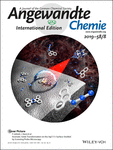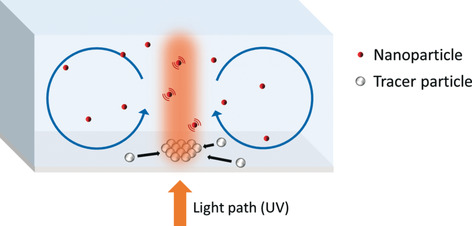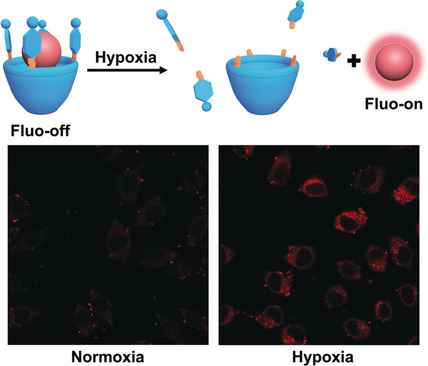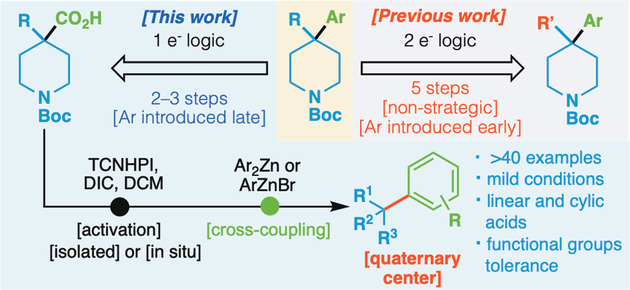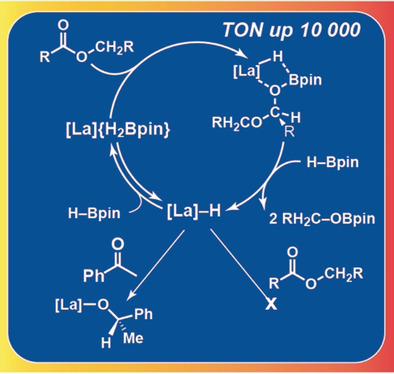Journal list menu
Export Citations
Download PDFs
Cover Pictures
Cover Picture: Aromatic Azide Transformation on the Ag(111) Surface Studied by Scanning Probe Microscopy (Angew. Chem. Int. Ed. 8/2019)
- Page: 2157
- First Published: 17 January 2019
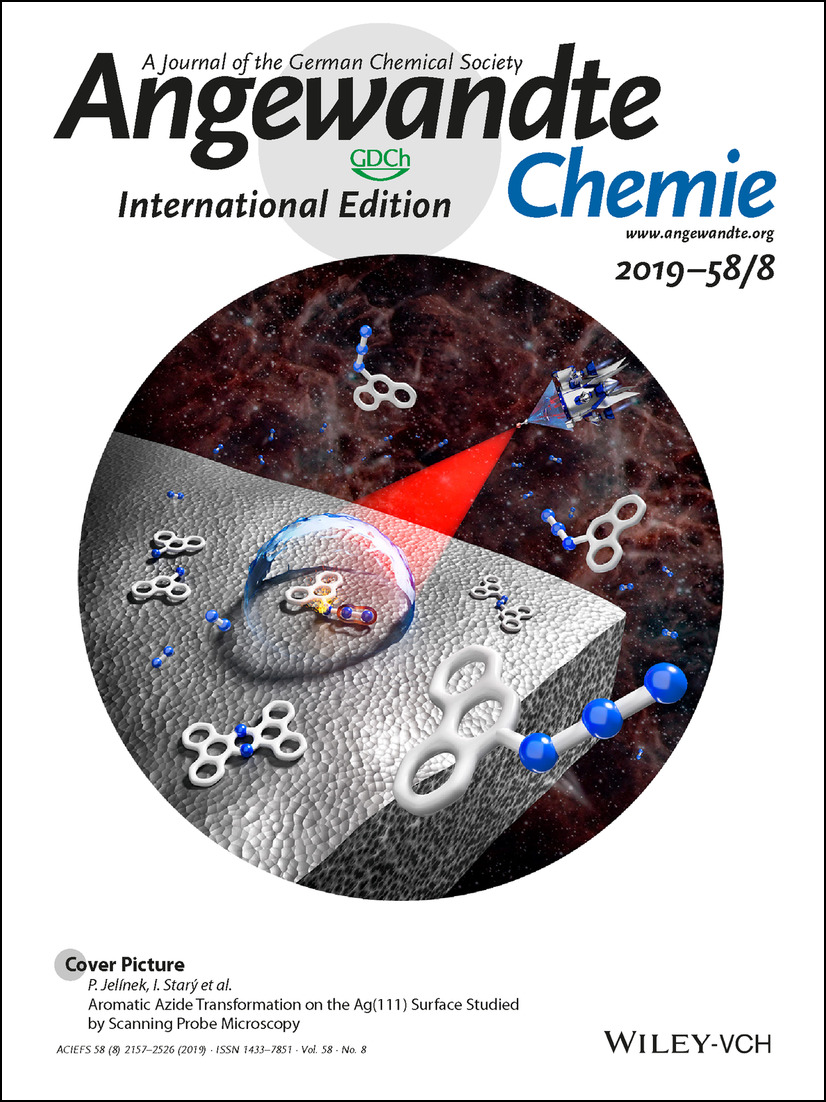
Transformation of aromatic azides on the silver surface was studied by atomic force microscopy in ultrahigh vacuum. In their Communication on page 2266, P. Jelínek, I. Starý et al. show that 9-azidophenanthrene decomposes into an elusive nitrenoid intermediate chemisorbed on the surface. It undergoes a formal nitrene insertion into a C−H bond, dimerisation, or hydrogenation to form covalent σ- and π-bonds in the dimeric or reduced products of the on-surface reactions.
Inside Cover: Bioinspired Engineering of a Multivalent Aptamer-Functionalized Nanointerface to Enhance the Capture and Release of Circulating Tumor Cells (Angew. Chem. Int. Ed. 8/2019)
- Page: 2158
- First Published: 25 January 2019
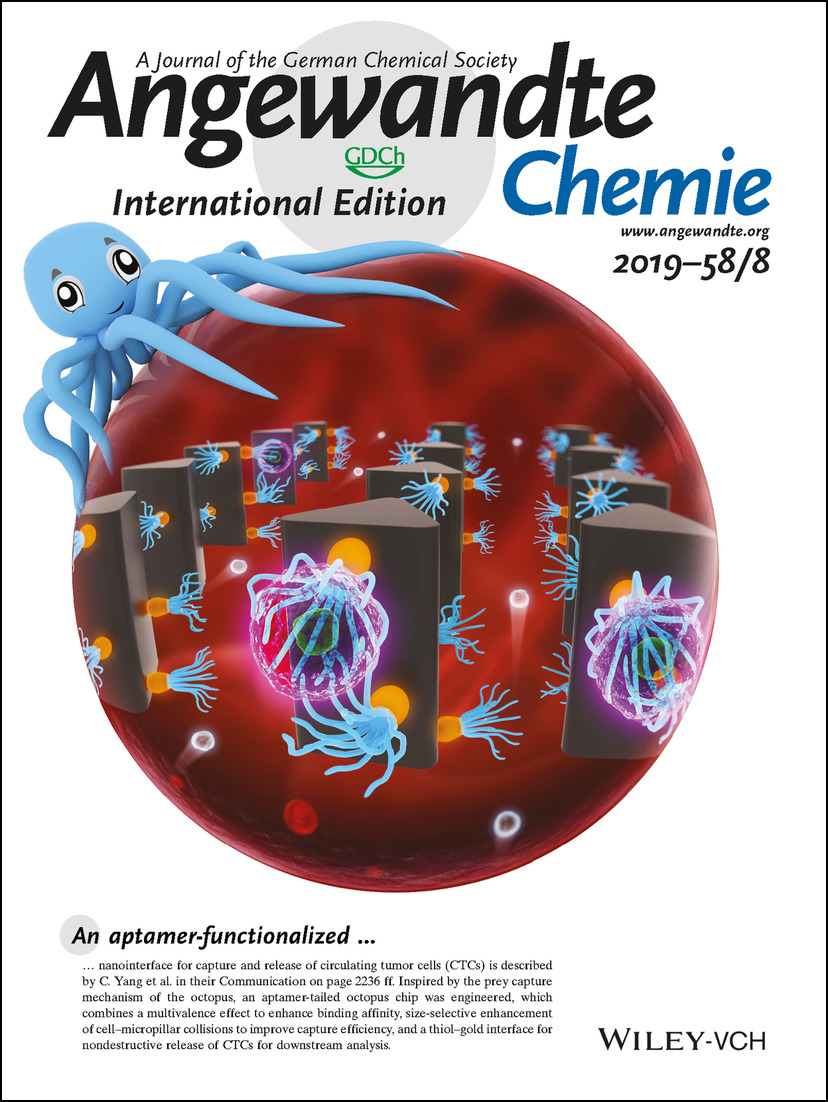
An aptamer-functionalized nanointerface for capture and release of circulating tumor cells (CTCs) is described by C. Yang et al. in their Communication on page 2236 ff. Inspired by the prey capture mechanism of the octopus, an aptamer-tailed octopus chip was engineered, which combines a multivalence effect to enhance binding affinity, size-selective enhancement of cell–micropillar collisions to improve capture efficiency, and a thiol–gold interface for nondestructive release of CTCs for downstream analysis.
Inside Back Cover: Atomically Dispersed Molybdenum Catalysts for Efficient Ambient Nitrogen Fixation (Angew. Chem. Int. Ed. 8/2019)
- Page: 2525
- First Published: 16 January 2019
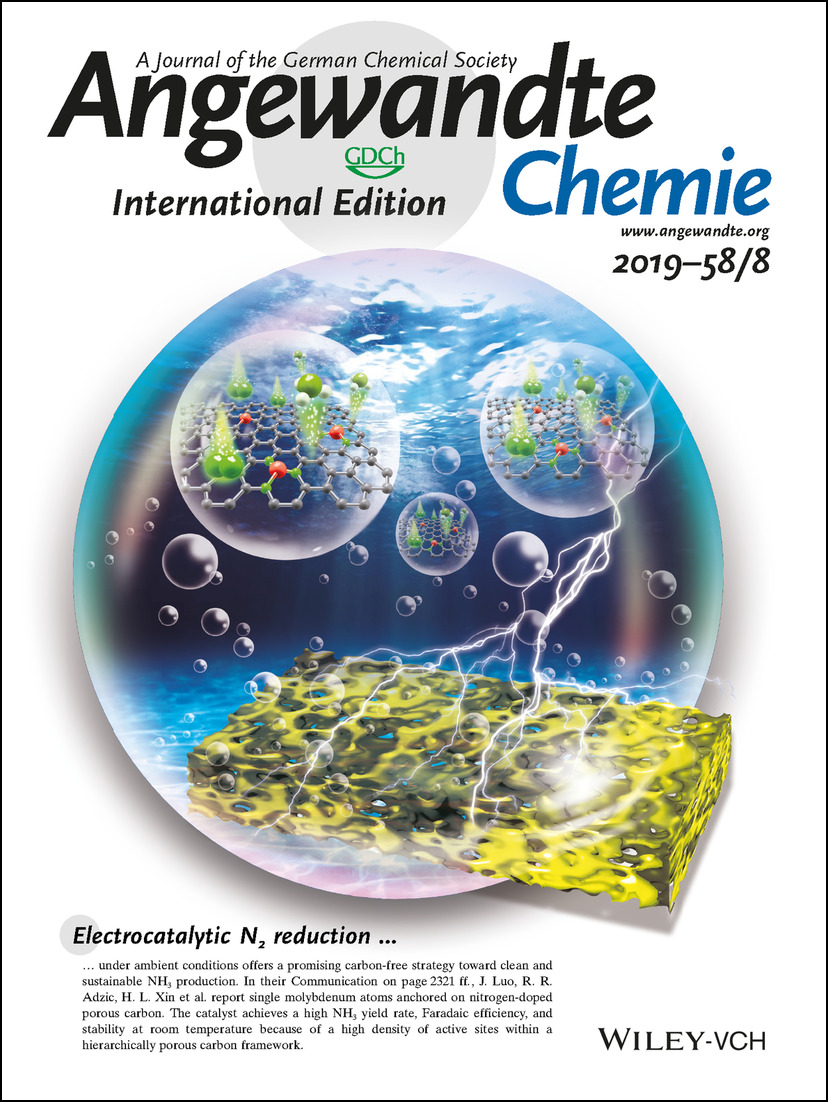
Electrocatalytic N2 reduction under ambient conditions offers a promising carbon-free strategy toward clean and sustainable NH3 production. In their Communication on page 2321 ff., J. Luo, R. R. Adzic, H. L. Xin et al. report single molybdenum atoms anchored on nitrogen-doped porous carbon. The catalyst achieves a high NH3 yield rate, Faradaic efficiency, and stability at room temperature because of a high density of active sites within a hierarchically porous carbon framework.
Back Cover: Organization of Particle Islands through Light-Powered Fluid Pumping (Angew. Chem. Int. Ed. 8/2019)
- Page: 2526
- First Published: 14 January 2019
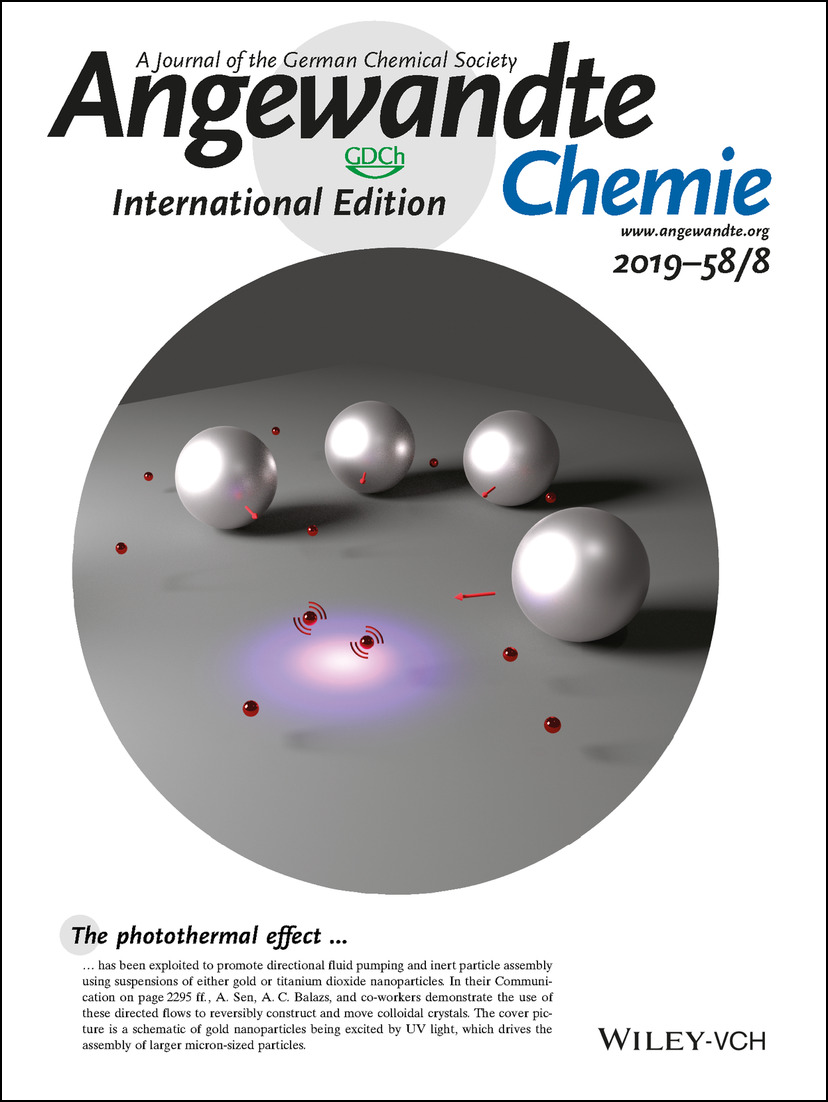
The photothermal effect has been exploited to promote directional fluid pumping and inert particle assembly using suspensions of either gold or titanium dioxide nanoparticles. In their Communication on page 2295 ff., A. Sen, A. C. Balazs, and co-workers demonstrate the use of these directed flows to reversibly construct and move colloidal crystals. The cover picture is a schematic of gold nanoparticles being excited by UV light, which drives the assembly of larger micron-sized particles.
Frontispiece
Frontispiece: A CO Adsorption Site Change Induced by Copper Substitution in a Ruthenium Catalyst for Enhanced CO Oxidation Activity
- First Published: 11 February 2019

Heterogeneous Catalysis. In their Communication on page 2230 ff., H. Kitagawa et al. show that decreasing the CO adsorption energy on Ru atoms by alloying with Cu atoms enhances the CO oxidation activity of CuxRu1−x nanoparticles.
Graphical Abstract
Graphical Abstract: Angew. Chem. Int. Ed. 8/2019
- Pages: 2161-2177
- First Published: 11 February 2019
Corrigenda
Corrigendum: The Remarkable Effect of Halogen Substitution on the Membrane Transport of Fluorescent Molecules in Living Cells
- Page: 2177
- First Published: 11 February 2019
News
Spotlights on our sister journals: Angew. Chem. Int. Ed. 8/2019
- Pages: 2180-2184
- First Published: 11 February 2019
Author Profile
News
Royal Australian Chemical Institute Awards 2018
- Pages: 2187-2188
- First Published: 09 January 2019
Minireviews
Micromachines
Chemotactic Micro- and Nanodevices
- Pages: 2190-2196
- First Published: 14 September 2018

Self-navigation: The chemotactic micro- and nanodevices are a specific group of machines capable of autonomous navigation in their environment. The capability of sensing a concentration gradient of a chemical compound differentiates them from other microdevices and allows possible applications in areas unavailable to externally driven systems. The current developments in the area is summarized and discussed.
Supramolecular Chemistry
Applications of Pillar[n]arene-Based Supramolecular Assemblies
- Pages: 2197-2206
- First Published: 13 June 2018
![Applications of Pillar[n]arene-Based Supramolecular Assemblies](/cms/asset/380929b8-939c-4961-8f5a-48ccc61a78b9/anie201805884-toc-0001-m.jpg)
A pillar of the community: In 2008, a new class of macrocycles, “pillar[n]arenes” was discovered. This Minireview describes application of pillar[n]arene-based supramolecular assemblies for supramolecular gel formation, reactions, light-harvesting systems, drug-delivery system, biochemical applications, separation and storage materials, and surface chemistry.
Reviews
Nanomotors
Dynamic Coupling at Low Reynolds Number
- Pages: 2208-2228
- First Published: 25 July 2018
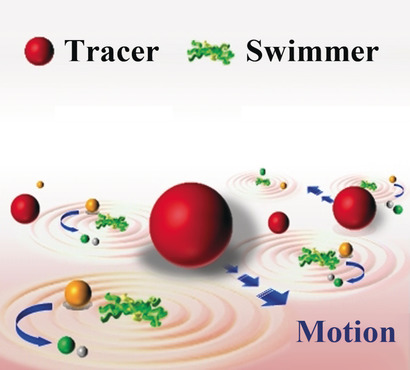
Self-propelled active swimmers, while transducing chemical energy into mechanical motion, considerably influence the dynamics of their surroundings. The controlled propulsion of motors offers the ability to impart and manipulate the motion of dispersed objects in liquids, which enables interaction principles of non-equilibrium systems to be identified and the behavior of dynamically coupled particle assemblies to be harnessed for useful applications.
Communications
Heterogeneous Catalysis | Hot Paper
A CO Adsorption Site Change Induced by Copper Substitution in a Ruthenium Catalyst for Enhanced CO Oxidation Activity
- Pages: 2230-2235
- First Published: 05 December 2018
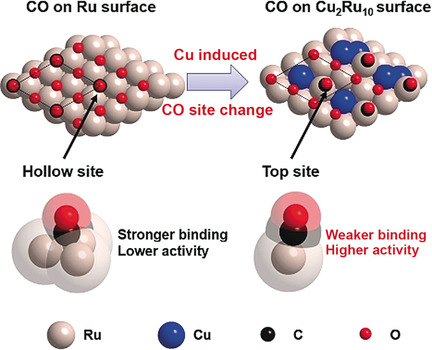
Copper helps out: The weakening of the CO adsorption energy on Ru atoms by alloying with Cu atoms plays an important role in the enhancement of the CO oxidation activity of CuxRu1−x nanoparticles. The weakening of the CO adsorption energy on Ru atoms originating from the CO adsorption site change was confirmed by experimental and theoretical investigations.
Analytical Methods
Bioinspired Engineering of a Multivalent Aptamer-Functionalized Nanointerface to Enhance the Capture and Release of Circulating Tumor Cells
- Pages: 2236-2240
- First Published: 13 December 2018
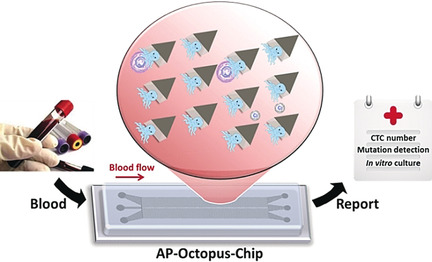
Octopus chip cell capture: Inspired by the high efficiency of the prey mechanism of the octopus, an aptamer-tailed octopus chip (AP-Octopus-Chip) for CTC enrichment was developed. The design of the chip and the high binding affinity of the multivalent structures against the target cells significantly improved the CTC capture efficiency and enrichment. The enriched cancer cells can be released through a thiol exchange reaction, which is fully compatible with downstream mutation detection and CTC culture.
C−H Activation
Selective C−H Functionalization of Methane and Ethane by a Molecular SbV Complex
- Pages: 2241-2245
- First Published: 27 December 2018

The high-oxidation-state complex SbV(TFA)5 is capable of selective C−H functionalization of methane and ethane to their corresponding mono and/or diol trifluoroacetate esters. Experimental and computational studies support a unique C−H activation mechanism mediated by SbV, which is then followed by functionalization of an organoantimony intermediate.
Peptide Biosynthesis
Introduction of d-Amino Acids in Minimalistic Peptide Substrates by an S-Adenosyl-l-Methionine Radical Epimerase
- Pages: 2246-2250
- First Published: 06 December 2018

Leader-free to d: Post-translational modifying enzymes from ribosomally synthesized peptide natural products offer new opportunities for small-molecule bioengineering. The in vitro analysis of an S-adenosyl-l-methionine radical enzyme is reported that generates d-amino acids in the core region of its native precursor protein substrate, as well as in leaderless linear and cyclic cores.
Metal Coordination | Hot Paper
Metal-Helix Frameworks from Short Hybrid Peptide Foldamers
- Pages: 2251-2255
- First Published: 17 December 2018
CO2 Electroreduction | Hot Paper
Enhanced Electroreduction of Carbon Dioxide to Methanol Using Zinc Dendrites Pulse-Deposited on Silver Foam
- Pages: 2256-2260
- First Published: 19 December 2018
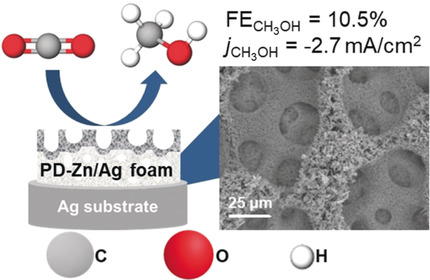
Full Metal Jacket: Zinc dendrites pulse-deposited on silver foam convert CO2 to CH3OH with a Faradaic efficiency (FE)CH₃OH of 10.5 % and a jCH₃OH of −2.7 mA cm−2 in aqueous solution. Strained, undercoordinated zinc atoms were identified as the active sites in a reaction pathway mediated by adsorbed CO and formaldehyde. Surprisingly, the stability of the *CHO intermediate does not influence the activity.
Fluorescent Probes
Gasotransmitter Regulation of Phosphatase Activity in Live Cells Studied by Three-Channel Imaging Correlation
- Pages: 2261-2265
- First Published: 27 December 2018
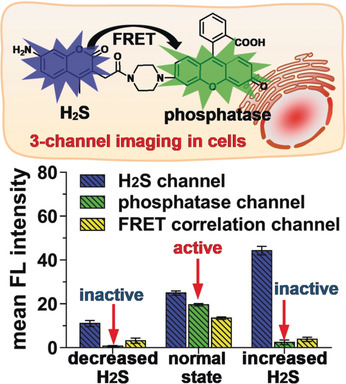
Two for one: A dual-reactive molecular probe has been devised to simultaneously measure intracellular H2S levels and phosphatase activity. Fluorescent analysis by three-channel imaging correlation reveals that a slight deviation from the normal H2S level leads to a sharp decrease of phosphatase activity.
On-Surface Reactivity | Hot Paper
Aromatic Azide Transformation on the Ag(111) Surface Studied by Scanning Probe Microscopy
- Pages: 2266-2271
- First Published: 02 January 2019

Coupling therapy with silver: Under ultrahigh vacuum, aryl azides generate an elusive chemisorbed nitrenoid intermediate on Ag(111). This intermediate can transform by forming covalent σ- and π-bonds via a formal nitrene insertion into a C−H bond, dimerisation, or hydrogenation. The structure of the transformation products was elucidated by high-resolution nc-AFM imaging supported by first-principle calculations.
Porphyrinoids
Boron(III) Carbazosubphthalocyanines: Core-Expanded Antiaromatic Boron(III) Subphthalocyanine Analogues
- Pages: 2272-2277
- First Published: 02 January 2019
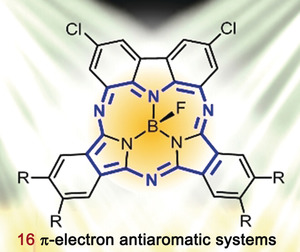
Core competencies: A series of novel core-expanded boron(III) subphthalocyanine analogues, namely boron(III) carbazosubphthalocyanines, have been synthesized and characterized. They represent the first examples of antiaromatic boron(III) subphthalocyanine derivatives and the smallest antiaromatic azaporphyrinoids reported thus far.
Double Perovskites
Colloidal Synthesis and Charge-Carrier Dynamics of Cs2AgSb1−yBiyX6 (X: Br, Cl; 0 ≤y ≤1) Double Perovskite Nanocrystals
- Pages: 2278-2283
- First Published: 21 December 2018
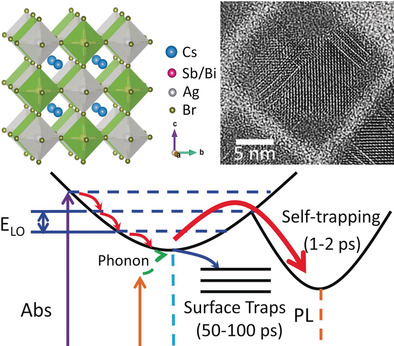
Caught in a trap: A series of new double perovskite nanocrystals Cs2AgSb1−yBiyX6 (X: Br, Cl; 0≤y≤1) is synthesized. Intrinsic self-trapping (ca. 1–2 ps) arising from giant carrier–phonon scattering and surface-defect trapping (ca. 50–100 ps) are revealed. Slow hot-carrier cooling is observed at high pump fluence.
Phosphorescence | Hot Paper
Paintable Room-Temperature Phosphorescent Liquid Formulations of Alkylated Bromonaphthalimide
- Pages: 2284-2288
- First Published: 12 December 2018

The room-temperature phosphorescence features of a solvent-free organic liquid phosphor in air were explored. Doping of the phosphor with carbonyl guests resulted in enhanced phosphorescence, and hence a large-area paintable phosphorescent liquid composite with improved lifetime and quantum yield was developed.
Radical Cyclization
Alkyne Versus Ynamide Reactivity: Regioselective Radical Cyclization of Yne-Ynamides
- Pages: 2289-2294
- First Published: 17 December 2018

Massive attack: An unprecedented radical cyclization of arylthiols with alkyne-tethered ynamides to give highly-substituted 4-arylthiopyrroles is reported. The transformation involves an unusual attack by a thiyl radical on the alkyne motif followed by cyclization with the ynamide core, which shows preferred reactivity of an alkyne over an ynamide. Density functional theory (DFT) studies support the proposed mechanism.
Self-Assembly | Very Important Paper
Organization of Particle Islands through Light-Powered Fluid Pumping
- Pages: 2295-2299
- First Published: 13 December 2018
Photoelectrochemistry | Hot Paper
Transparent Ta3N5 Photoanodes for Efficient Oxygen Evolution toward the Development of Tandem Cells
- Pages: 2300-2304
- First Published: 12 December 2018
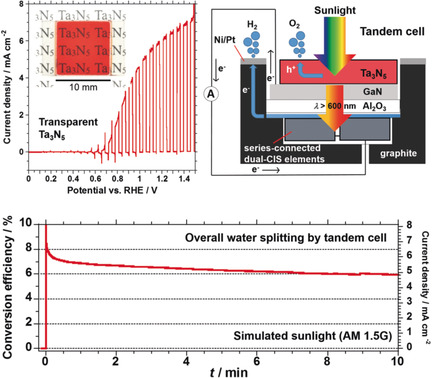
A transparent Ta3N5 photoanode was fabricated on GaN/Al2O3 substrate to develop the tandem cell for overall water splitting. The transparency of Ta3N5/GaN/Al2O3 to wavelengths longer than 600 nm allowed incoming solar light to be transmitted to a CuInSe2 (CIS). A stand-alone tandem cell with a serially-connected dual-CIS-based cathode was constructed. This tandem cell exhibited an initial solar-to-hydrogen energy conversion efficiency of 7 %.
Biocatalysis | Hot Paper
An Esterase-like Lyase Catalyzes Acetate Elimination in Spirotetronate/Spirotetramate Biosynthesis
- Pages: 2305-2309
- First Published: 21 January 2019
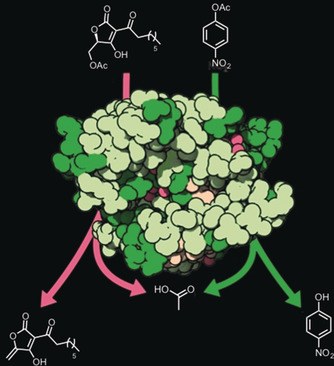
To eliminate, or to hydrolyze, that is the question: Structural, mechanistic, and computational studies of the abyssomicin C pathway enzyme AbyA5 establish the molecular origins of enzyme-catalyzed acetate elimination. The unexpected acetyl-esterase-like scaffold of the protein is shown to support both acetate elimination and ester hydrolysis, in a manner dictated by substrate identity.
Host–Guest Materials
A Three-Dimensional Dynamic Supramolecular “Sticky Fingers” Organic Framework
- Pages: 2310-2315
- First Published: 14 December 2018

A sticky situation: An unprecedented pure, dynamic, crystalline framework held together with weak “sticky fingers” van der Waals interactions has been developed. The fullerene-based material exhibits a remarkable single-crystal-to-single-crystal hydrogenation reaction accompanied by a color change in the visible range.
Oxygen Evolution Reaction
Double Perovskite LaFexNi1−xO3 Nanorods Enable Efficient Oxygen Evolution Electrocatalysis
- Pages: 2316-2320
- First Published: 04 January 2019
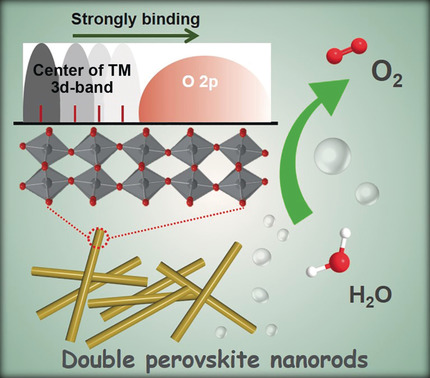
Double perovskite nanorods LaFexNi1−xO3 (LFNO NRs) with reduced diameter have been successfully created and adopted as efficient OER catalysts. The optimized LFNO NRs have proper d-band electronic structure, enabling strong binding between adsorbates and NRs, which boosts their intrinsic OER activity.
Nitrogen Fixation
Atomically Dispersed Molybdenum Catalysts for Efficient Ambient Nitrogen Fixation
- Pages: 2321-2325
- First Published: 12 December 2018
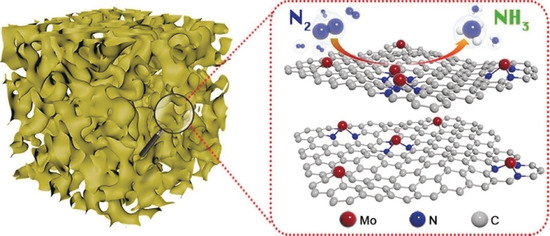
Single molybdenum atoms anchored on nitrogen-doped porous carbon were designed and synthesized for the electrocatalytic reduction of N2 to NH3. The catalyst exhibited high electrocatalytic activity and stability, which is attributed to its structure, conductive carbon support, high porosity, and well-dispersed single molybdenum atoms.
Biosynthesis
Control Mechanism for cis Double-Bond Formation by Polyunsaturated Fatty-Acid Synthases
- Pages: 2326-2330
- First Published: 08 January 2019
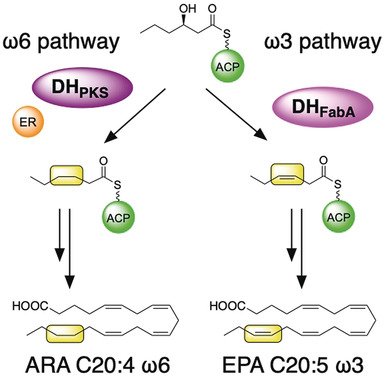
Growing chains: Eicosapentaenoic acid (EPA) synthase and arachidonic acid (ARA) synthase, both of which are composed of large enzyme complexes with multiple catalytic domains, utilize two types of dehydratase (DH) domains. The domain used depends on the carbon-chain length and can lead to introduction of either saturation or cis double bonds to the growing acyl chains. ACP=acyl-carrier protein, PKS=polyketide synthase.
G-Quadruplexes
A Minimal Sequence for Left-Handed G-Quadruplex Formation
- Pages: 2331-2335
- First Published: 27 November 2018
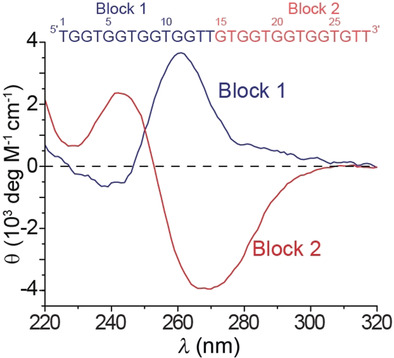
It's just a jump to the left: Based on analysis and modification of the two sequence blocks of the natural left-handed DNA G-quadruplex Z-G4, the 12-nt sequence GTGGTGGTGGTG was identified as a minimal sequence motif for left-handed G-quadruplex formation. This motif is abundant in the human genome.
Metal–Organic Frameworks
Nylon–MOF Composites through Postsynthetic Polymerization
- Pages: 2336-2340
- First Published: 03 December 2018
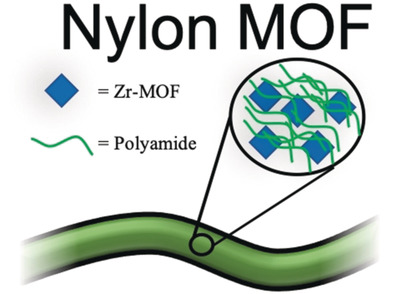
Two become one: The hybridization of metal-organic frameworks (MOFs) and nylon polymers into composites through postsynthetic polymerization is reported. This simple, scalable, bench-top approach provides a new method to design hybrid materials containing MOFs and polymers while maintaining the desired properties of both materials.
Imaging Agents
A Chemogenetic Approach for the Optical Monitoring of Voltage in Neurons
- Pages: 2341-2344
- First Published: 20 December 2018
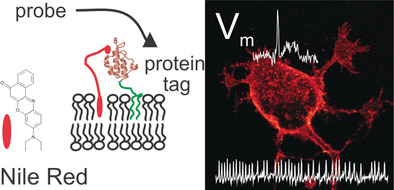
Shine a light: A semisynthetic tethered voltage indicator (STeVI1) based upon nile red is described that displays voltage sensitivity when genetically targeted to neuronal membranes. This environmentally sensitive probe allows for wash-free imaging and faithfully detects supra- and sub-threshold activity in neurons.
Lithium–Oxygen Batteries | Hot Paper
A Stable Lithium–Oxygen Battery Electrolyte Based on Fully Methylated Cyclic Ether
- Pages: 2345-2349
- First Published: 27 December 2018

Full methyl jacket: A fully methylated cyclic ether 4,4,5,5-hexamethyl-1,3-dioxolane is used as an electrolyte solvent for Li–O2 batteries. It exhibits excellent stability in the presence of superoxide or singlet oxygen because all the active α-H atoms are substituted with methyl groups. The cycling performance is 4 times greater that of conventional ether electrolytes.
Photodynamic Therapy | Very Important Paper
Nucleus-Targeted Organoiridium–Albumin Conjugate for Photodynamic Cancer Therapy
- Pages: 2350-2354
- First Published: 15 December 2018

On target: A nucleus-targeted organo-iridium-HSA conjugate for photodynamic therapy has been developed. Phosphorescence of a weakly emissive maleimide-functionalized Ir complex is greatly enhanced when conjugated to human serum albumin. The iridium-HSA conjugate targets the nucleus and generates 1O2 for photodynamic therapy upon irradiation with visible light.
Lithium–Oxygen Batteries | Very Important Paper
A Versatile Halide Ester Enabling Li-Anode Stability and a High Rate Capability in Lithium–Oxygen Batteries
- Pages: 2355-2359
- First Published: 20 December 2018
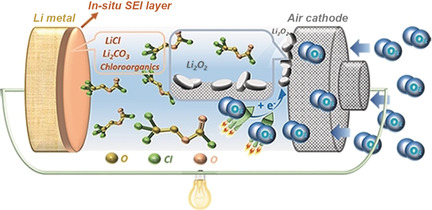
Ester came early: The introduction of 2,2,2-trichloroethyl chloroformate into the electrolyte of a Li–O2 battery leads to an outstanding rate capability (2005 mAh g−1) with a remarkably decreased charge potential at a current density of 1000 mA g−1. The positive effect is associated with the improved solubility of Li2O2 in the electrolyte and the increased diffusion rate of O2.
Intercalation
The Color of the Elements: A Combined Experimental and Theoretical Electron Density Study of ScB2C2
- Pages: 2360-2364
- First Published: 20 December 2018
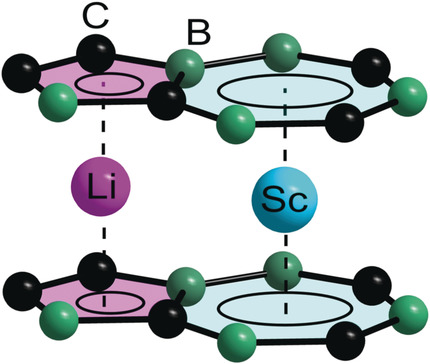
Electron deficiency: The high-resolution X-ray diffraction provides all the essential information to decode even complex coloring problems in chemistry such as the disorder-induced electronic doping in ScB2C2. This information lead to the synthesis of the first bimetallic hetero-metallocene with lithium and scandium atoms embedded in pentagonal and heptagonal voids, respectively.
Heterocycles
Umpolung Reactivity of Ynamides: An Unconventional [1,3]-Sulfonyl and [1,5]-Sulfinyl Migration Cascade
- Pages: 2365-2370
- First Published: 19 December 2018
![Umpolung Reactivity of Ynamides: An Unconventional [1,3]-Sulfonyl and [1,5]-Sulfinyl Migration Cascade](/cms/asset/a71dd9c1-5b7e-47d1-934c-041a31ea9f64/anie201813143-toc-0001-m.jpg)
Double migration: A regioselective umpolung [1,3]-sulfonyl/[1,5]-sulfinyl migration cycloisomerization cascade of alkyne-tethered ynamides allows the construction of unconventional 4-sulfinylated pyrroles through deaurative [1,5]-sulfinylation. Density functional theory was used to study the reaction pathway.
Cross-Coupling Reactions
Intermolecular Heck Coupling with Hindered Alkenes Directed by Potassium Carboxylates
- Pages: 2371-2376
- First Published: 02 January 2019
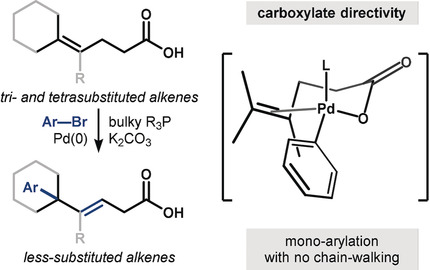
The arylation of tri- and tetrasubstituted olefins directed by pendant carboxylic acids is reported. Quaternary carbons are established at high Fsp3 attached-ring junctures and the carboxylate directing group can be removed after the coupling. Carboxylate directivity prevents over-arylation of the new, less substituted alkene, which can be diversified in subsequent reactions.
Imaging Agents
A Noncovalent Fluorescence Turn-on Strategy for Hypoxia Imaging
- Pages: 2377-2381
- First Published: 10 January 2019
Asymmetric Catalysis | Hot Paper
Guanidine–Copper Complex Catalyzed Allylic Borylation for the Enantioconvergent Synthesis of Tertiary Cyclic Allylboronates
- Pages: 2382-2386
- First Published: 07 January 2019
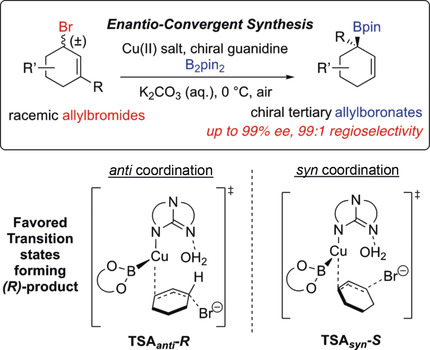
An enantioconvergent synthesis of chiral cyclic allylboronates from racemic allylic bromides was achieved with a guanidine–copper catalyst. The allylboronates were obtained with high γ/α regioselectivities (up to 99:1) and enantioselectivities (up to 99 % ee) in a reaction that is believed to go through an SN2′ borylation process.
DNA Structure
Energetic Basis of AGCGA-Rich DNA Folding into a Tetrahelical Structure
- Pages: 2387-2391
- First Published: 08 January 2019
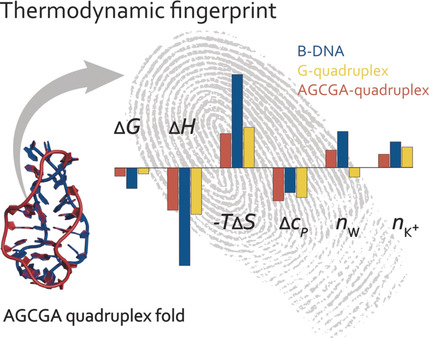
Folding energetics of a novel class of noncanonical DNA structure, termed AGCGA-quadruplex, are reported. Compared to B-DNA and G-quadruplexes, these structures have a distinguishing thermodynamic fingerprint. Base-stacking, hydrophobic desolvation, conformational breathing, and specific binding of water molecules are the main energetic contributions driving the AGCGA-quadruplex folding.
Palladium Catalysis
Palladium(II)-Catalyzed Enantioselective Aminotrifluoromethoxylation of Unactivated Alkenes using CsOCF3 as a Trifluoromethoxide Source
- Pages: 2392-2396
- First Published: 29 January 2019

PdII-catalyzed enantioselective intramolecular aminotrifluoromethoxylation of unactivated alkenes using readily accessible and stable CsOCF3 as a trifluoromethoxide source has been developed, which affords a wide variety of enantiomerically enriched β-substituted OCF3-containing piperidines in good yields. Introducing a sterically bulky group into pyridine-oxazoline (Pyox) ligands is crucial to increasing both reactivity and enantioselectivity.
Supercapacitors
Heteroatom-Doped Porous Carbon Materials with Unprecedented High Volumetric Capacitive Performance
- Pages: 2397-2401
- First Published: 08 January 2019
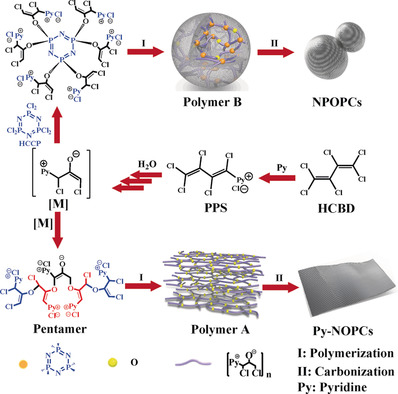
Porous and full of potential: An unconventional polymer-derived strategy for the large-scale synthesis of high-density heteroatom-doped porous carbon materials is reported. The resulting supercapacitor shows a volumetric energy density of 36.8 Wh L−1 in alkaline electrolytes, which is the highest among currently available carbon-based aqueous supercapacitors.
Photocatalysis
Deaminative (Carbonylative) Alkyl-Heck-type Reactions Enabled by Photocatalytic C−N Bond Activation
- Pages: 2402-2406
- First Published: 19 December 2018

Single-electron process: A deaminative alkyl-Heck-type reaction and its carbonylative variant proceed through photocatalytic C−N bond activation. This process represents a significant complement to the classic palladium-catalyzed Heck reaction, and features easily available starting materials, good reaction efficiency, and mild reaction conditions. Tppy=2,4,6-triphenylpyridine.
Theranostics | Very Important Paper
One-Dimensional Fe2P Acts as a Fenton Agent in Response to NIR II Light and Ultrasound for Deep Tumor Synergetic Theranostics
- Pages: 2407-2412
- First Published: 02 January 2019
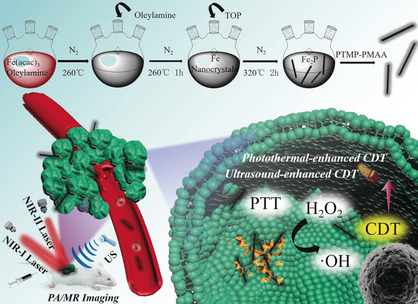
Sound and light: Biocompatible 1D ferrous phosphide nanorods (FP NRs) have ultrasound (US) and photothermal (PT)-enhanced Fenton properties and high photothermal conversion efficiency (56.6 %) in the NIR II window, showing excellent synergistic therapeutic properties. FP NRs can also be used as a photoacoustic imaging (PAI) and magnetic resonance imaging (MRI) agent.
Radiolabeling
Synthesis and Reactivity of α-Cumyl Bromodifluoromethanesulfenate: Application to the Radiosynthesis of [18F]ArylSCF3
- Pages: 2413-2417
- First Published: 21 December 2018
![Synthesis and Reactivity of α-Cumyl Bromodifluoromethanesulfenate: Application to the Radiosynthesis of [18F]ArylSCF3](/cms/asset/d870f30c-4240-41a9-a539-85c55a92dcd5/anie201813708-toc-0001-m.jpg)
On the radio: A highly reactive electrophilic bromodifluoromethylthiolating reagent, α-cumyl bromodifluoromethanesulfenate, was developed and coupled with a range of (hetero)aryl boronic pinacol esters under copper catalysis. The resulting bromodifluoromethylthiolated (hetero)arenes were amenable to halogen exchange using [18F]KF/K222. This is the first radiosynthetic route to [18F]arylSCF3 via (hetero)aryl–SCF3 bond construction.
Quaternary Amino Acids
Asymmetric and Geometry-Selective α-Alkenylation of α-Amino Acids
- Pages: 2418-2422
- First Published: 02 January 2019
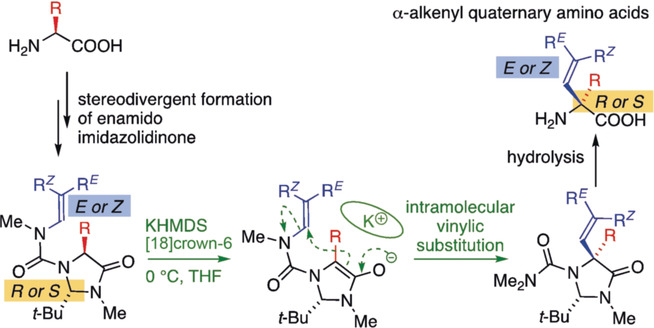
Stereocontrol: E- and Z-N′-alkenyl urea derivatives of imidazolidinones may be formed selectively from enantiopure α-amino acids. Generation of their enolate derivatives in the presence of K+ and [18]crown-6 induces intramolecular migration of the alkenyl group from N′ to Cα. Hydrolysis of the enantiopure products under acid conditions reveals quaternary α-alkenyl amino acids.
Host–Guest Systems
Reversible Optical Writing and Data Storage in an Anthracene-Loaded Metal–Organic Framework
- Pages: 2423-2427
- First Published: 11 December 2018
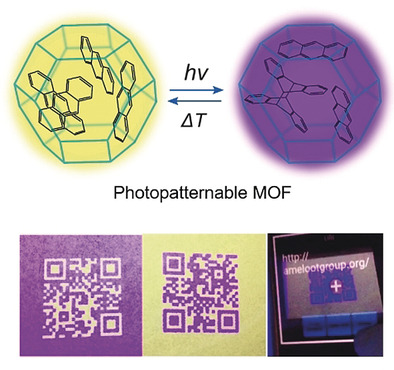
The confinement of anthracene molecules in a metal–organic framework enables reversible yellow-to-purple photoswitching of the fluorescence emission. The photoresponse of the host–guest system strongly relies on the unique properties of the MOF host, that is, the pore geometry, connectivity, and volume as well as the structural flexibility. The solid-state photoswitching enabled the development of photopatternable, erasable, and rewritable paper.
Biocatalysis
One-Pot Bioconversion of l-Arabinose to l-Ribulose in an Enzymatic Cascade
- Pages: 2428-2432
- First Published: 03 January 2019
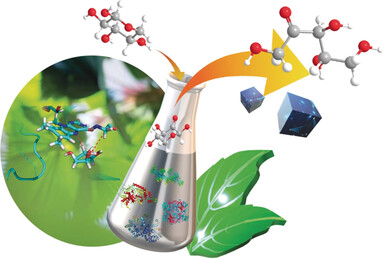
A spoonful of sugar: A new concept for the synthesis of l-ribulose from l-arabinose was successfully established using a one-pot bioconversion consisting of engineered pyranose 2-oxidase, xylose reductase, formate dehydrogenase, and catalase. Transient kinetics in combination with molecular dynamics simulations indicate that the sugar substrate is positioned closer to the FAD N5-position in the engineered pyranose 2-oxidase than in the wild-type.
Immunology
Proactively Reducing Anti-Drug Antibodies via Immunomodulatory Bioconjugation
- Pages: 2433-2436
- First Published: 10 January 2019

Immunomodulatory bioconjugation: An immunomodulator rapamycin was conjugated to a PEGylated protein therapeutic via a cleavable disulfide linker. This immunomodulatory bioconjugation effectively reduces anti-drug antibody (ADA) generation by inducing antigen-specific immune tolerance. The reported approach breaks the limitations of PEGylation by the proactive prevention of the generation of ADAs.
Lithium Batteries
Stabilizing Lithium into Cross-Stacked Nanotube Sheets with an Ultra-High Specific Capacity for Lithium Oxygen Batteries
- Pages: 2437-2442
- First Published: 21 December 2018
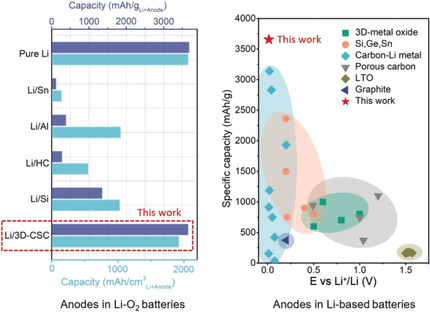
Charged up! A lithium anode with an ultra-high specific capacity (3656 mAh g−1) is achieved by cross-stacking aligned carbon nanotubes into porous networks. Owing to the dendrite-free morphology and stabilized solid–electrolyte interface, lithium–oxygen batteries using this anode show a five-fold enhanced cycling stability compared to those using conventional Li anodes.
Gold–π Interactions
Unusual Attractive Au–π Interactions in Small Diacetylene-Modified Gold Clusters
- Pages: 2443-2447
- First Published: 06 January 2019
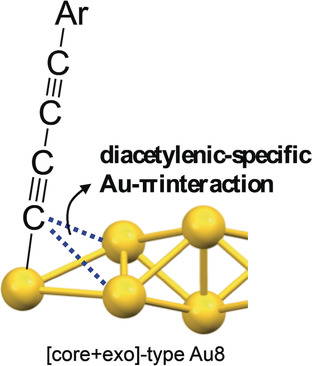
A golden π-crust: Unprecedented attractive Au–π interactions were found between a σ-coordinating C≡C moiety and neighboring gold atoms of diacetylene-modified Au8 clusters. The interaction was observed specifically for the diacetylenic ligands, and not found in the mono-acetylenic analogues, indicating the uniqueness of the diacetylenic ligands.
Heterogeneous Catalysis
Constructing Mononuclear Palladium Catalysts by Precoordination/Solvothermal Polymerization: Recyclable Catalyst for Regioselective Oxidative Heck Reactions
- Pages: 2448-2453
- First Published: 02 January 2019
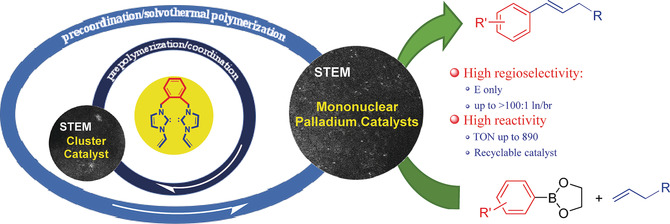
Pop around: Reported herein is a precoordination/solvothermal polymerization strategy to fabricate a stable atomically dispersed mononuclear Pd-metalized N-heterocyclic carbene doped porous organic polymer catalyst (Pd@POP). This Heck reaction of electronically unbiased alkenes is the first to be catalyzed by a recyclable catalyst (Pd@POP-9) with unprecedented catalytic activity and regioselectivity.
Radical Coupling | Hot Paper
Quaternary Centers by Nickel-Catalyzed Cross-Coupling of Tertiary Carboxylic Acids and (Hetero)Aryl Zinc Reagents
- Pages: 2454-2458
- First Published: 08 January 2019
Asymmetric Catalysis
Direct Catalytic Asymmetric Aldol Reaction of α-Alkoxyamides to α-Fluorinated Ketones
- Pages: 2459-2463
- First Published: 16 January 2019

Combining oxygen and fluorine: α-Oxygen-functionalized amides were employed as enolate surrogates in a direct catalytic aldol coupling with α-fluorinated ketones. Because of the likely involvement of open transition states, both syn- and anti-aldol adducts can be accessed with high enantioselectivity by judicious choice of the chiral ligands.
Chiral Zinc(II)-Catalyzed Enantioselective Tandem α-Alkenyl Addition/Proton Shift Reaction of Silyl Enol Ethers with Ketimines
- Pages: 2464-2468
- First Published: 15 January 2019

Surprise shift: An efficient route to β-amino silyl enol ethers by an α-alkenyl addition/proton shift sequence from silyl enol ethers to ketimines has been developed. Good enantioselectivities with a broad substrate scope were achieved using chiral N,N′-dioxide/ZnII complexes. Deuterium-labeling studies suggest that a key proton shift is involved in this reaction.
Organocatalysis
One-Pot Catalytic Enantioselective Synthesis of 2-Pyrazolines
- Pages: 2469-2473
- First Published: 18 December 2018

On the double: A scalable, one-pot, enantioselective catalytic synthesis of 2-pyrazolines from beta-substituted enones and hydrazines is described. The method uses a readily prepared cinchona-derived bifunctional catalyst. Pivoting on a two-stage catalytic Michael addition/condensation strategy, the use of an aldehyde to generate a hydrazone derivative of the hydrazine is key for curtailing background reactivity and tuning the catalyst-controlled enantioselectivity.
Asymmetric Synthesis
Enantioselective Synthesis of 3,3′-Diaryl-SPINOLs: Rhodium-Catalyzed Asymmetric Arylation/BF3-Promoted Spirocyclization Sequence
- Pages: 2474-2478
- First Published: 02 January 2019

Going for a ′SPIN′: The enantioselective synthesis of a series of 3,3′-diarylated 1,1′-spirobiindane-7,7′-diols (3,3′-diaryl-SPINOLs) was developed using a sequential Rh-catalyzed twofold asymmetric conjugate arylation/BF3-promoted diastereoselective spirocyclization. Some phosphoramidite ligands were prepared from the 3,3′-Ph-SPINOL and applied to several catalytic asymmetric reactions, and the 3,3′-diarylated ligands showed higher enantioselectivities than the privileged nonsubstituted ligands.
Carbenoids
Telescoped, Divergent, Chemoselective C1 and C1-C1 Homologation of Imine Surrogates: Access to Quaternary Chloro- and Halomethyl-Trifluoromethyl Aziridines
- Pages: 2479-2484
- First Published: 11 December 2018

Mono- or bis-homologation was realized with lithium halocarbenoids for the assembly of trifluoromethyl aziridines. Trifluoroacetimidoyl chlorides act as electrophilic platforms, enabling the addition of either one or two homologating elements. Use of two different carbenoids leads to fluoromethyl analogues in which the first nucleophile is employed for constructing the cycle and the second one for decorating the resulting molecular architecture.
Ligand Design
PhPAd-DalPhos: Ligand-Enabled, Nickel-Catalyzed Cross-Coupling of (Hetero)aryl Electrophiles with Bulky Primary Alkylamines
- Pages: 2485-2489
- First Published: 03 January 2019
Total Synthesis
Allylic Compounds
Direct Carbohydroxylation of Arylalkenes with Allylic Alcohols: Cooperative Catalysis of Copper, Silver, and a Brønsted Acid
- Pages: 2495-2499
- First Published: 02 January 2019

Forming a partnership: The cooperative catalysis of copper, silver, and a Brønsted acid is presented as a new strategy for olefin functionalization. The direct catalytic carbohydroxylation of styrenes with allylic alcohols proceeds smoothly with excellent regioselectivity under mild reaction conditions.
Cycloaddition
Cobalt-Catalyzed Intermolecular [2+2] Cycloaddition between Alkynes and Allenes
- Pages: 2500-2504
- First Published: 07 January 2019
![Cobalt-Catalyzed Intermolecular [2+2] Cycloaddition between Alkynes and Allenes](/cms/asset/9b355a2d-0f71-42dd-a1a7-4379da082e16/anie201813283-toc-0001-m.jpg)
In equal measure: A cobalt/diphosphine catalyst promotes a selective [2+2] cycloaddition reaction between an alkyne and an allene, affording a 3-alkylidenecyclobutene with high regioselectivity. The reaction tolerates various internal alkynes, and mono- and disubstituted allenes with different functional groups, and can be achieved using a near equimolar mixture of the unsaturated reactants.
Homogeneous Catalysis
Interconverting Lanthanum Hydride and Borohydride Catalysts for C=O Reduction and C−O Bond Cleavage
- Pages: 2505-2509
- First Published: 19 December 2018
Radicals | Hot Paper
Copper-Catalyzed Remote C(sp3)−H Trifluoromethylation of Carboxamides and Sulfonamides
- Pages: 2510-2513
- First Published: 07 January 2019

From a distance: Chemoselective trifluoromethylation of unactivated C(sp3)−H bonds distal to the functional group was achieved under mild, copper-catalyzed conditions. A radical mechanism involving 1,5-hydrogen atom transfer of N-radicals followed by CF3-transfer from CuII−CF3 complexes to the thus formed alkyl radicals is proposed.
Asymmetric Catalysis | Hot Paper
An Enantioselective CpxRh(III)-Catalyzed C−H Functionalization/Ring-Opening Route to Chiral Cyclopentenylamines
- Pages: 2514-2518
- First Published: 02 January 2019

Hand in hand: A chiral CpxRhIII catalyst system generated from a CpxRhI(cod) precatalyst and bis(o-toluoyl) peroxide engages in aryl and alkenyl C−H activation/ring-opening sequences between ketoxime ethers and 2,3-diazabicyclo[2.2.1]hept-5-enes. The transformation provides densely functionalized chiral cyclopentenylamines in excellent yields and high enantioselectivities.
Microporous Materials
Template-Free Synthesis of Highly b-Oriented MFI-Type Zeolite Thin Films by Seeded Secondary Growth
- Pages: 2519-2523
- First Published: 21 January 2019
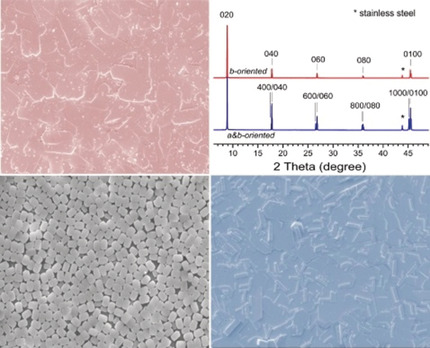
Thin films: The effect of compositional constraints on the synthesis of highly b-oriented MFI zeolite films on stainless-steel plates using secondary growth solutions, free of organic template, was investigated. The number of twin crystals can be significantly reduced, and even eliminated, simply by restricting the pH value of the secondary growth solutions to the narrow range of 11.1–11.3.




